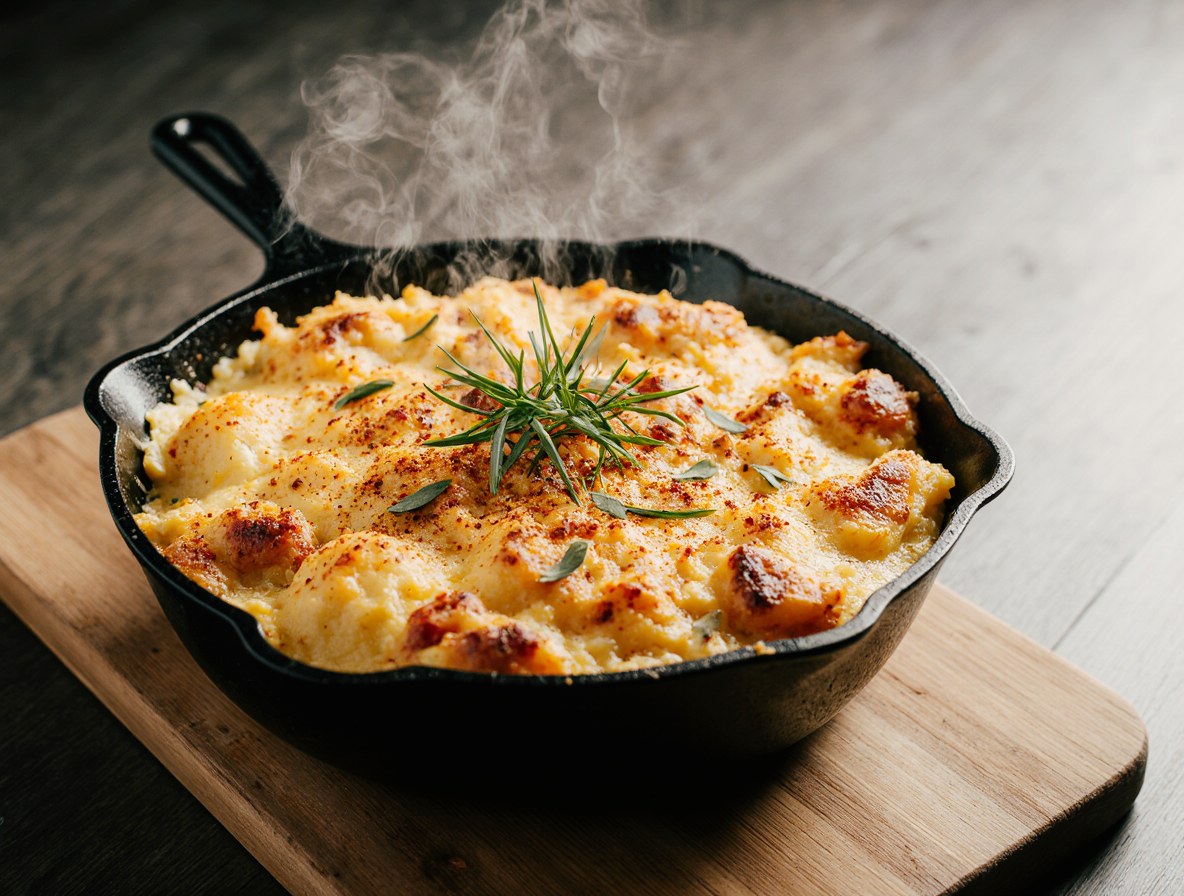How to Make Hash Brown Egg Casserole: A Foolproof Breakfast Recipe
Looking for the perfect breakfast that combines comfort and satisfaction? Our hash brown egg casserole packs an impressive 616 calories per serving, making it a hearty way to start your day.
When we call this egg casserole with hash browns “fully loaded,” we’re not exaggerating. This gluten-free breakfast option combines all our favorite ingredients: crispy hash browns, protein-rich eggs, savory cheese, and your choice of breakfast meats. Whether you’re cooking for a family gathering or meal prepping for the week, this hash brown egg breakfast casserole yields 6 generous servings and provides an excellent balance of 49g fat, 30g carbs, and 34g protein per serving.
The best part? Our recipe for hash brown egg casserole is surprisingly simple to prepare. With just 20 minutes of prep time and about an hour of baking, you can have a complete meal ready to serve. Perfect for busy mornings, this hash brown egg casserole recipe can even be prepared ahead of time and simply popped in the oven when needed.
Gather Your Ingredients
The foundation of any successful hash brown egg casserole starts with gathering the right ingredients. I’ve found that having everything prepped and ready before assembly makes the entire cooking process smoother and more enjoyable.
Essential items for a classic hash brown egg casserole
For a traditional hash brown egg casserole that serves 6-8 people, you’ll need:
- 1-2 pounds of shredded hash browns (thawed if using frozen)
- 8-9 large eggs, lightly beaten
- 1-1½ cups of shredded cheese (sharp cheddar works wonderfully)
- ¾ cup sour cream for creaminess
- ½ cup milk to create the perfect egg texture
- ½ cup chopped onion for savory depth
- 1 teaspoon salt and ¼ teaspoon pepper for proper seasoning
The protein element is customizable—choose between 1 pound of breakfast sausage, 8-16 ounces of chopped bacon, or about 1½ cups of diced ham. Each brings its unique flavor profile to the dish.
Optional add-ins for extra flavor
What makes this recipe truly adaptable is how easily you can customize it. Consider these flavorful additions:
For vegetables, red bell peppers add beautiful color and sweet flavor to your casserole. Additionally, mushrooms, zucchini, or even spinach make excellent nutritious additions. Many families find this casserole is an ideal vehicle for “sneaking” vegetables into picky eaters’ diets.
Regarding cheese options, while sharp cheddar is a classic choice, trying a combination of cheeses creates more complex flavors. A mixture of sharp cheddar with pepper jack adds a welcome kick, while Swiss or Monterey Jack cheese offers milder alternatives.
For extra flavor dimension, incorporate:
- ½ teaspoon onion powder
- ⅛ teaspoon garlic powder
- 1 teaspoon hot sauce (optional but recommended)
- ¾ cup cottage cheese for incredible creaminess
Tips for using frozen vs. fresh hash browns
Frozen hash browns provide remarkable convenience without sacrificing nutrition. In fact, nutritional differences between fresh and frozen hash browns are minimal. Frozen varieties typically contain just three ingredients: potatoes, dextrose (which prevents browning), and sodium acid pyrophosphate (for consistent color).
If using fresh potatoes instead, plan for extra preparation time. You’ll need to wash, peel, and shred the potatoes with a cheese grater. Furthermore, fresh-shredded potatoes release excess moisture that must be addressed—place them in a strainer to drain or pat them dry with paper towels.
One important tip: some cooks prefer partially cooking frozen hash browns before assembly. Though not strictly necessary, this extra step creates a pleasant browned potato flavor in the final dish. Alternatively, for a crispy bottom layer, spread fresh-grated potatoes in a thin layer in your baking dish and pre-cook them slightly before adding other ingredients.
Step-by-Step Assembly Guide
Assembling your hash brown egg casserole requires attention to order and technique. Let me walk you through the process step by step to ensure perfect results every time.
Prepare the baking dish
Initially, preheat your oven to 350°F (175°C), which provides the ideal temperature for evenly cooking your hash brown egg casserole. Next, generously grease a 9×13-inch baking dish or 3-quart casserole dish with cooking spray or butter to prevent sticking. This simple preparation step is crucial for easy serving later. Some recipes recommend using parchment paper as an additional non-stick measure, especially helpful if your dish tends to stick.
Cook and layer the meat or veggies
For a meat version, cook breakfast sausage or bacon in a large skillet over medium-high heat until fully browned, about 10 minutes. Drain excess fat thoroughly to prevent a greasy casserole. In the same skillet, sauté onions and bell peppers for approximately 5-6 minutes until softened. Adding minced garlic during the final minute enhances flavor significantly. Once cooked, transfer this mixture to your prepared baking dish.
Whisk the egg mixture
In a large bowl, whisk together eggs, milk, salt, pepper, and seasonings like garlic powder and onion powder until well combined. The ratio typically works best with 8-9 eggs to 1 cup of milk for the perfect consistency. Consider adding dried mustard for a subtle flavor enhancement. Afterward, stir in 1½ cups of shredded cheese, reserving some for the top.
Layer everything in the right order
Start by spreading thawed hash browns evenly across the bottom of your prepared dish. Subsequently, distribute your cooked meat and vegetables over the potatoes. Pour the egg mixture over everything, ensuring it seeps through the layers. Gently press ingredients down with a spoon to submerge them in the egg mixture. Finally, sprinkle the remaining cheese across the top for that golden-brown finish. Cover with aluminum foil before baking for best results.
Baking and Make-Ahead Instructions
Baking is the critical final step that transforms your assembled ingredients into a delicious hash brown egg casserole. Proper timing and temperature ensure perfect results every time.
How long to bake and at what temperature
Preheat your oven to 350°F (175°C) for standard baking. Place your casserole in the center rack and bake covered with foil for the first 30-45 minutes. Once this initial period passes, remove the foil and continue baking uncovered for an additional 30-35 minutes until the edges become bubbly and golden brown. The total baking time typically ranges from 55-65 minutes. If you prefer a slightly higher temperature, 375°F works well with a reduced cooking time of about 40-50 minutes.
Make-ahead tips for busy mornings
One exceptional advantage of hash brown egg breakfast casserole is its make-ahead potential. Assemble your casserole completely, cover tightly with plastic wrap or foil, then refrigerate for up to 48 hours prior to baking. Alternatively, prepare it the evening before and refrigerate overnight. On baking day, remove the casserole from the refrigerator at least 30 minutes before baking to reduce the chill. Remember that refrigerated casseroles generally require an extra 10-15 minutes of baking time. For maximum flavor development, allow ingredients to mingle for at least 2 hours in the refrigerator.
How to tell when it’s fully cooked
A properly cooked hash brown egg casserole should reach an internal temperature of 160°F measured with a food thermometer. The traditional knife test works well too – insert a knife near the center; it should come out clean when the casserole is done. Nevertheless, the edges should appear set and lightly browned. The center might still have a slight jiggle but shouldn’t be liquid. Allow your finished casserole to rest for 5-10 minutes before serving – this helps it set completely for cleaner slices.
Storage, Reheating, and Freezing Tips
Properly stored hash brown egg casserole extends your breakfast enjoyment beyond a single meal. Let me share proven methods for keeping your casserole fresh and delicious.
How to store leftovers safely
After cooking, allow your hash brown egg casserole to cool completely before storing to prevent moisture buildup. Place leftovers in an airtight container in the refrigerator for 4-5 days. According to food safety guidelines, refrigerate within 2 hours of baking to prevent bacterial growth. For individual portions, consider dividing the casserole before storing to simplify future reheating.
Best ways to reheat without drying out
The secret to perfectly reheated hash brown egg casserole lies in moisture retention. For oven reheating, cover loosely with aluminum foil and warm at 350°F until the internal temperature reaches 165°F. Remove foil during the last 5-10 minutes to restore some crispiness. Alternatively, microwave individual portions in 30-second intervals with a damp paper towel covering the dish. Moreover, adding ¼ cup of milk or water before reheating works wonders for preventing dryness.
Freezing instructions for long-term storage
Freeze your hash brown egg casserole either before or after baking. For unbaked freezing, assemble completely, wrap tightly with plastic wrap followed by foil, and freeze for up to 3 months. For baked casseroles, cool completely first, then wrap similarly. Thaw overnight in the refrigerator before reheating or baking. Properly frozen casseroles maintain quality for 2-4 months depending on packaging quality.
Conclusion
Hash brown egg casserole stands as the ultimate crowd-pleasing breakfast option for both everyday mornings and special gatherings. After all, few dishes offer such a perfect balance of convenience and hearty satisfaction. This versatile recipe truly delivers on its promise of being fully loaded – crispy potatoes, protein-rich eggs, savory cheese, and your choice of breakfast meats combine to create a complete meal in one dish.
What makes this casserole particularly appealing is its adaptability. You can easily customize ingredients based on your family’s preferences or what’s available in your refrigerator. Additionally, the make-ahead capability transforms busy mornings into stress-free experiences. Simply prepare everything the night before, then bake it fresh when needed.
Proper storage techniques extend your enjoyment beyond a single meal. Leftovers remain delicious for several days when refrigerated correctly, while freezing options provide long-term meal planning solutions. Most importantly, reheating methods preserve the original texture and flavor without drying out your casserole.
This recipe proves that nutritious, satisfying breakfasts don’t require culinary expertise or hours in the kitchen. The straightforward preparation process yields impressive results with minimal effort. Therefore, whether you’re feeding a hungry family or meal prepping for yourself, hash brown egg casserole deserves a regular spot in your breakfast rotation. Give this foolproof recipe a try, and you’ll undoubtedly find it becomes a cherished staple in your household.
FAQs
Q1. How long can I store leftover hash brown egg casserole in the refrigerator? Leftover hash brown egg casserole can be safely stored in an airtight container in the refrigerator for 4-5 days. Make sure to refrigerate it within 2 hours of baking to maintain food safety.
Q2. Can I prepare hash brown egg casserole ahead of time? Yes, you can prepare hash brown egg casserole ahead of time. Assemble the casserole completely, cover it tightly, and refrigerate for up to 48 hours before baking. Remember to remove it from the refrigerator about 30 minutes before baking and add 10-15 minutes to the baking time.
Q3. What’s the best way to reheat hash brown egg casserole without drying it out? To reheat without drying out, cover the casserole loosely with aluminum foil and warm it in a 350°F oven until it reaches an internal temperature of 165°F. Remove the foil for the last 5-10 minutes to restore crispiness. For individual portions, microwave with a damp paper towel cover.
Q4. Can I freeze hash brown egg casserole? Yes, you can freeze hash brown egg casserole either before or after baking. Wrap it tightly in plastic wrap and foil, and it can be frozen for up to 3 months. Thaw overnight in the refrigerator before reheating or baking.
Q5. What are some optional ingredients I can add to customize my hash brown egg casserole? You can customize your hash brown egg casserole by adding ingredients like red bell peppers, mushrooms, zucchini, or spinach for extra nutrition. For cheese variations, try a mix of sharp cheddar and pepper jack, or use Swiss or Monterey Jack for milder flavors. You can also add seasonings like onion powder, garlic powder, or a dash of hot sauce for extra flavor.


